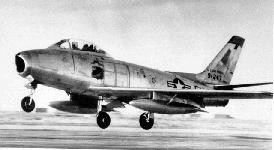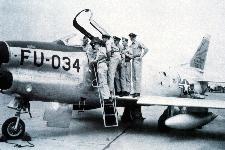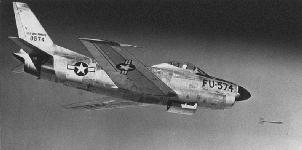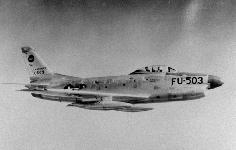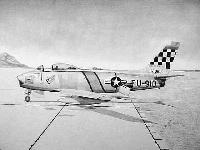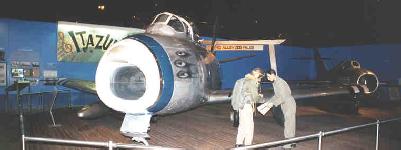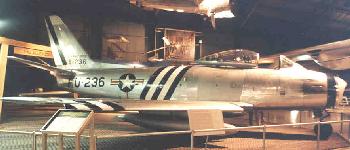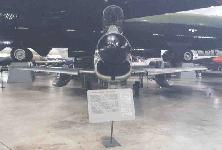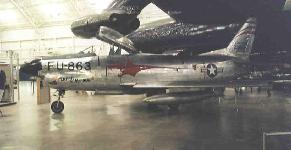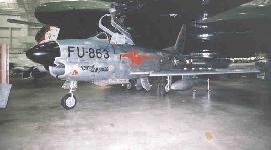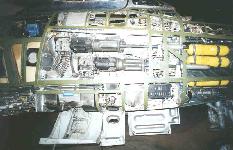| VRML 3-D Model |
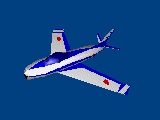 F-86 Blue Impulse VRML by Soji Yamakawa |




The F-86, the U. S. Air Force's first swept-wing jet fighter, made its initial flight on October 1, 1947. Originally designed as a high-altitude day fighter, it was subsequently redesigned into an all-weather interceptor (F-86D) and a fighter bomber (F-86H). Armed with six 50 caliber machine guns, the Sabre pilot had to be in visual contact with the enemy in order to attempt a shoot-down, thereby making it the last true 'dogfighter' in the Air Force inventory.
The F86 Sabre was originally designed for the US Navy in 1945 as a straight-winged jet fighter, and was known as the XJ Fury. North American Aviation, already famous for its P-51 Mustang and B-25 Billy Mitchell bomber, was put under contract by the US Army Air Force to produce a new jet fighter. Utilizing information captured from the Germans, innovative technologies were employed in transforming the straight-winged XFJ-1 into the swept-wing F-86 Sabre that would dominate the skies over Korea in the 1950s.
The Sabre represented many firsts in technology and design. Swept-wing configuration has become a standard for jet-powered aircraft. The then revolutionary but now commonplace 'flying tail' allows the aircraft excellent maneuverability at high altitudes. In addition, the Sabre employs a hydraulic system for the movement of the flight controls, eliminating the excessive control stick forces necessary to maneuver other types of airplanes at high speeds.
The Sabre was delivered to the Air Force in 1948. The first production model flew on May 20, 1948, and on September 15, 1948, an F-86A set a new world speed record of 670.9 mph. Originally designated as the F-86A, the Sabre would undergo a number of changes resulting in a variety of model designations.
Known for its combat role in the Korean conflict, this aircraft was single-handedly responsible for turning the fide of the air war in favor of the United States. As a day fighter, the airplane saw service in Korea in three successive series (F-86A, E, and F) where it engaged the Russian built MiG-15. The F-86 Sabre was introduced in November 1950 and rushed to Korea to challenge the tactical edge of the MiG-15. The MiG's pilots were very good, being (for the most part) veteran Russian fliers. But the USF soon had a counter to the MiG-15�the superb F-86A (and later, F-86E/F) Sabre. Many of the Sabre pilots were veterans of World War II and their expertise showed. Soon the Sabres and MiGs were mixing it up over northwest Korea, an area that became known as "MiG Alley." On December 17, 1950, Lt. Col. Bruce Hinton was the first Sabre pilot to score the first of an estimated 818 MiG-15 kills.
Replacing the earlier -A and -E models, the -F featured a new '6-3' wing without the slats found on the leading edge of the earlier models. The increased chord of the wing (6 inches at the root and 3 inches at the tip) and small boundary layer fences gave better maneuvering performance at high speeds. A General Electric J47-27 engine powered the F-86F; producing 6,000 pounds of thrust the aircraft can achieve a speed of 695 mph and can exceed the speed of sound in a shallow dive. It is capable of climb rates up to 10,000 feet per minute and can fly as high as 50,000 feet. The -F was used both as an air superiority fighter and fighter-bomber during the latter stages of the war; replacing the F-80 and F-51 aircraft still being used in the Korean combat in 1952.
While the war turned into a stalemate on the ground, MiG Alley remained a hot spot throughout the war. For a time the B-29s continued bombing targets in northwest Korea by day, but when MiG-15s shot down five Superfortresses in a week in October 1951, the big bombers began attacking only at night. Day after day, though, the Sabres (joined by F-84 Thunderjets or F-80s) swept into MiG Alley to meet the MiG-15s rising from their fields in Manchuria. Although the U.S. government directed that these fields were "off limits" to the FEAF aircraft, some of these planes occasionally strayed across the border in "hot pursuit" of enemy aircraft.
By the end of hostilities, it had shot down 792 MiGs at a loss of only 76 Sabres, a victory ratio of 10 to 1. In the hands of skillful pilots, the Sabre's 10-1 Kill ratio over the MiG-15 was the best achieved in any sustained fighter campaign. Of the 40 pilots to earn the designation of 'ace' (five or more kills) during the Korean war, all but one flew the F-86 Sabre. By July of 1953, no fighter aircraft in the world could take on the Sabre without being at a disadvantage. It is no wonder the F-86 Sabre is widely acknowledged along with the P-51 Mustang and the F-4 Phantom- as one of the three great fighter aircraft in US history.
The F-86L was a modified F-86D, with upgrades to the original radar/fire control systems to provide 'data-link' capability between the aircraft and ground controllers, eliminating the use of vocal instructions during intercept missions. New wing slats and an increase in wing span of 2 feet improved performance of the -L over the -D.
Over 9,800 F-86s were manufactured during the years of 1947 through 1957, making it the most prolific jet fighter ever produced. More than 5,500 Sabre day fighters were built in the U. S. and Canada. The airplane was also used in the air forces of twenty other nations, including West Germany, Japan, Spain, Britain, and Australia.
Warner Robins Air Logistics Center (WR-ALC) had logistics management responsibility for the guns, communications, fire control and bombing-navigational equipment installed on F-86 aircraft. From 1953 to 1958, under Project High Flight, more than 500 F-86s were processed through the WR-ALC maintenance shops to prepare them for ferrying across the Atlantic to U. S. Air Forces in Europe and our NATO allies.
Specifications | |
| Wing Span | 35 feet, 11 inches |
| Length | 37 feet, 6 inches |
| Height | 14 feet, 8 inches |
| Weight | 13,791 lbs. loaded |
| Armament | Six .50-caliber machine guns and eight 5-inch rockets or 2,000 lbs. of bombs |
| Engine | One General Electric J47 engine with 5,200 lbs. of thrust |
| Cost | $178,000 |
| Maximum speed | 685 mph |
| Cruising speed | 540 mph |
| Range | 1,200 miles |
| Service Ceiling | 49,000 feet |
| VRML 3-D Model |
 F-86 Blue Impulse VRML by Soji Yamakawa |
